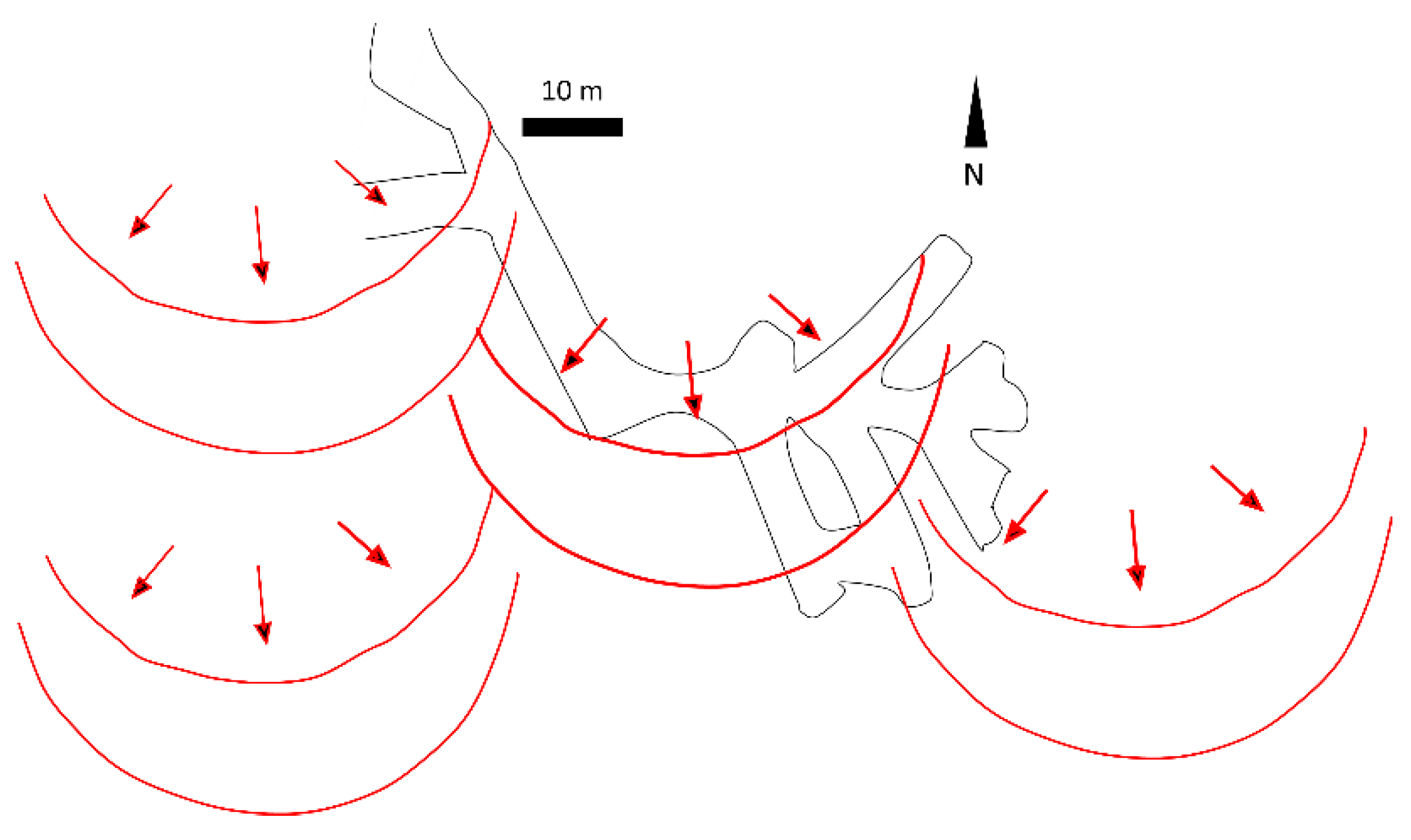Preliminary Mineralogical Characterization of Branching Selenite Gypsum: New Insights for the Paleoenvironmental Reconstruction and Mechanical Characterization
Abstract
:1. Introduction
2. Geological Framework
3. Methodologies
4. Results
4.1. Textural Features
4.2. Compositional Analyses
4.3. Clay Characterization
- -
- illite
- -
- chlorite
- -
- smectite
- -
- a mixed-layer family consisting of three layers of smectite and one of chlorite
- -
- a mixed-layer family consisting of three layers of smectite and one of illite
5. Discussion
5.1. Depositional Context of the Branching Selenite Facies
5.2. Clay Minerals
5.3. Implications for Quarry Exploitation
- uniaxial compression strength (UCS), i.e., the value of strength of the material under mechanical compression on cylindrical samples;
- strength index (Is50), i.e., the parameter obtained with the point load test (PLT), an expeditive test that measures the failure load of samples between two punctual conical points of contact. This parameter is directly related to the UCS through empirical relationships;
- ultrasonic pulse velocity (UPV), i.e., the velocity of a seismic wave (produced as an ultrasonic pulse) through the material. This value depends on the physical properties of the material (e.g., solid density, porosity, mineralogical composition and presence of cracks) and gives an indirect measure of its mechanical strength.
6. Conclusions
Supplementary Materials
Author Contributions
Funding
Data Availability Statement
Acknowledgments
Conflicts of Interest
References
- Rouchy, J.M.; Caruso, A. The Messinian Salinity Crisis in the Mediterranean Basin: A Reassessment of the Data and an Integrated Scenario. Sediment. Geol. 2006, 188, 35–67. [Google Scholar] [CrossRef]
- Hsu, K.J.; Cita, M. The origin of the Mediterranean evaporites. Initial. Rep. Deep. Sea Drill. Proj. 1973, 13, 1203–1231. [Google Scholar]
- Butler, R.W.H.; Lickorish, W.H.; Grasso, M.; Pedley, H.M.; Ramberti, L. Tectonics and Sequence Stratigraphy in Messinian Basins, Sicily: Constraints on the Initiation and Termination of the Mediterranean Salinity Crisis. GSA Bull. 1995, 107, 425–439. [Google Scholar] [CrossRef]
- Hilgen, F.; Krijgsman, W. Cyclostratigraphy and Astrochronology of the Tripoli Diatomite Formation (Pre-Evaporite Messinian, Sicily, Italy). Terra Nova 1999, 11, 16–22. [Google Scholar] [CrossRef]
- Krijgsman, W.; Meijer, P.T. Depositional Environments of the Mediterranean “Lower Evaporites” of the Messinian Salinity Crisis: Constraints from Quantitative Analyses. Mar. Geol. 2008, 253, 73–81. [Google Scholar] [CrossRef]
- Dela Pierre, F.; Clari, P.; Bernardi, E.; Natalicchio, M.; Costa, E.; Cavagna, S.; Lozar, F.; Lugli, S.; Manzi, V.; Roveri, M.; et al. Messinian Carbonate-Rich Beds of the Tertiary Piedmont Basin (NW Italy): Microbially-Mediated Products Straddling the Onset of the Salinity Crisis. Palaeogeogr. Palaeoclimatol. Palaeoecol. 2012, 344–345, 78–93. [Google Scholar] [CrossRef]
- Manzi, V.; Lugli, S.; Roveri, M.; Dela Pierre, F.; Gennari, R.; Lozar, F.; Natalicchio, M.; Schreiber, B.C.; Taviani, M.; Turco, E. The Messinian Salinity Crisis in Cyprus: A Further Step Towards a New Stratigraphic Framework for Eastern Mediterranean. Basin Res. 2016, 28, 207–236. [Google Scholar] [CrossRef]
- Sabino, M.; Dela Pierre, F.; Natalicchio, M.; Birgel, D.; Gier, S.; Peckmann, J. The Response of Water Column and Sedimentary Environments to the Advent of the Messinian Salinity Crisis: Insights from an Onshore Deep-Water Section (Govone, NW Italy). Geol. Mag. 2021, 158, 825–841. [Google Scholar] [CrossRef]
- Briand, F. (Ed.) CIESM The Messinian Salinity Crisis from Mega-Deposits to Microbiology—A Consensus Report. In Proceedings of the N° 33 in CIESM Workshop Monographs, Almeira, Spain, 7–10 November 2007; CIESM Publisher: Paris, Monaco, 2008; p. 168. [Google Scholar]
- Manzi, V.; Roveri, M.; Gennari, R.; Bertini, A.; Biffi, U.; Giunta, S.; Iaccarino, S.M.; Lanci, L.; Lugli, S.; Negri, A.; et al. The Deep-Water Counterpart of the Messinian Lower Evaporites in the Apennine Foredeep: The Fanantello Section (Northern Apennines, Italy). Palaeogeogr. Palaeoclimatol. Palaeoecol. 2007, 251, 470–499. [Google Scholar] [CrossRef]
- Lugli, S.; Manzi, V.; Roveri, M.; Schreiber, C.B. The Primary Lower Gypsum in the Mediterranean: A New Facies Interpretation for the First Stage of the Messinian Salinity Crisis. Palaeogeogr. Palaeoclimatol. Palaeoecol. 2010, 297, 83–99. [Google Scholar] [CrossRef]
- Vai, G.B.; Ricci Lucchi, F. Algal crusts, autochthonous and clastic gypsum in a cannibalistic evaporite basin: A Case History from the Messinian of Northern Apennines. Sedimentology 1977, 24, 211–244. [Google Scholar] [CrossRef]
- Sturani, C. Messinian Facies in the Piedmont Basin. Mem. Della Soc. Geol. Ital. 1976, 16, 11–25. [Google Scholar]
- Dela Pierre, F.; Bernardi, E.; Cavagna, S.; Clari, P.; Gennari, R.; Irace, A.; Lozar, F.; Lugli, S.; Manzi, V.; Natalicchio, M.; et al. The Record of the Messinian Salinity Crisis in the Tertiary Piedmont Basin (NW Italy): The Alba Section Revisited. Palaeogeogr. Palaeoclimatol. Palaeoecol. 2011, 310, 238–255. [Google Scholar] [CrossRef]
- Dronkert, H. The Evaporites of the Sorbas Basin; Instituto de Investigaciones Geológicas Diputación Provincial Universidad de Barcelona: Barcelona, Spain, 1977; Volume 32, pp. 55–76. [Google Scholar]
- Caselle, C.; Bonetto, S.; Colombero, C.; Comina, C. Mechanical Properties of Microcrystalline Branching Selenite Gypsum Samples and Influence of Constituting Factors. J. Rock Mech. Geotech. Eng. 2019, 11, 228–241. [Google Scholar] [CrossRef]
- Caselle, C.; Bonetto, S.; Vagnon, F.; Costanzo, D. Dependence of Macro Mechanical Behaviour of Gypsum on Micro-Scale Grain-Size Distribution. Géotechnique Lett. 2019, 9, 1–9. [Google Scholar] [CrossRef] [Green Version]
- Ramon, A.; Caselle, C.; Bonetto, S.M.R.; Costanzo, D.; Alonso, E.E. Effect of Microstructure and Relative Humidity on Strength and Creep of Gypsum. Rock Mech. Rock Eng. 2021, 54, 4121–4145. [Google Scholar] [CrossRef]
- Rossi, M.; Mosca, P.; Polino, R.; Rogledi, S.; Biffi, U. New outcrop and subsurface data in the Tertiary Piedmont Basin (NW-Italy): Unconformity-Bounded Stratigraphic Units and their Relationships with Basin-Modification Phases. Riv. Ital. Paleontol. Stratigr. 2009, 115, 305–355. [Google Scholar] [CrossRef]
- Bertotti, G.; Mosca, P. Late Orogenic Vertical Movements within the Arc of the SW Alps and Ligurian Alps. Tectonophysics 2009, 475, 117–127. [Google Scholar] [CrossRef]
- Dela Pierre, F.; Natalicchio, M.; Lozar, F.; Bonetto, S.; Carnevale, G.; Cavagna, S.; Colombero, S.; Sabino, M.; Violanti, D. The Northernmost Record of the Messinian Salinity Crisis (Piedmont Basin, Italy) Regional Commitee on Mediterranean Neogeone Stratigraphy Interim Colloquium—Torino, 25–28 September 2014. Geol. Field Trips 2016, 8, 2–58. [Google Scholar] [CrossRef]
- Caselle, C.; Bonetto, S.; Comina, C. Comparison of Laboratory and Field Electrical Resistivity Measurements of a Gypsum Rock for Mining Prospection Applications. Int. J. Min. Sci. Technol. 2019, 29, 603–604. [Google Scholar] [CrossRef]
- Dumon, M.; Van Ranst, E. PyXRD v0.6.7: A Free and Open-Source Program to Quantify Disordered Phyllosilicates Using Multi-Specimen X-Ray Diffraction Profile Fitting. Geosci. Model Dev. 2016, 9, 41–57. [Google Scholar] [CrossRef] [Green Version]
- Evans, N.P.; Turchyn, A.V.; Gázquez, F.; Bontognali, T.R.R.; Chapman, H.J.; Hodell, D.A. Coupled Measurements of Δ18O and ΔD of Hydration Water and Salinity of Fluid Inclusions in Gypsum from the Messinian Yesares Member, Sorbas Basin (SE Spain). Earth Planet. Sci. Lett. 2015, 430, 499–510. [Google Scholar] [CrossRef] [Green Version]
- Cipriani, M.; Dominici, R.; Costanzo, A.; D’Antonio, M.; Guido, A. A Messinian Gypsum Deposit in the Ionian Forearc Basin (Benestare, Calabria, Southern Italy): Origin and Paleoenvironmental Indications. Minerals 2021, 11, 1305. [Google Scholar] [CrossRef]
- Natalicchio, M.; Pellegrino, L.; Clari, P.; Pastero, L.; Dela Pierre, F. Gypsum Lithofacies and Stratigraphic Architecture of a Messinian Marginal Basin (Piedmont Basin, NW Italy). Sediment. Geol. 2021, 425, 106009. [Google Scholar] [CrossRef]
- de Lange, G.J.; Krijgsman, W. Messinian Salinity Crisis: A Novel Unifying Shallow Gypsum/Deep Dolomite Formation Mechanism. Mar. Geol. 2010, 275, 273–277. [Google Scholar] [CrossRef]
- Yaremchuk, Y.; Hryniv, S.; Peryt, T.; Vovnyuk, S.; Meng, F. Controls on Associations of Clay Minerals in Phanerozoic Evaporite Formations: An Overview. Minerals 2020, 10, 974. [Google Scholar] [CrossRef]
- Iaremchuk, I.; Tariq, M.; Hryniv, S.; Vovnyuk, S.; Meng, F. Clay Minerals from Rock Salt of Salt Range Formation (Late Neoproterozoic–Early Cambrian, Pakistan). Carbonates Evaporites 2017, 32, 63–74. [Google Scholar] [CrossRef]
- Caselle, C.; Penone, A.; Bonetto, S. Preliminary Mechanical Characterization of Gypsum Rock Using UCS and Point Load Test Correlation. Geoing. Ambient. E Min. 2018, 153, 60–67. [Google Scholar]
- Caselle, C.; Umili, G.; Bonetto, S.; Costanzo, D.; Ferrero, A.M. Evolution of Local Strains Under Uniaxial Compression in an Anisotropic Gypsum Sample. In Proceedings of the Geotechnical Research for Land Protection and Development, Lecco, Italy, 3–5 July 2019; Calvetti, F., Cotecchia, F., Galli, A., Jommi, C., Eds.; Springer International Publishing: Cham, Switzerland, 2020; pp. 454–461. [Google Scholar]
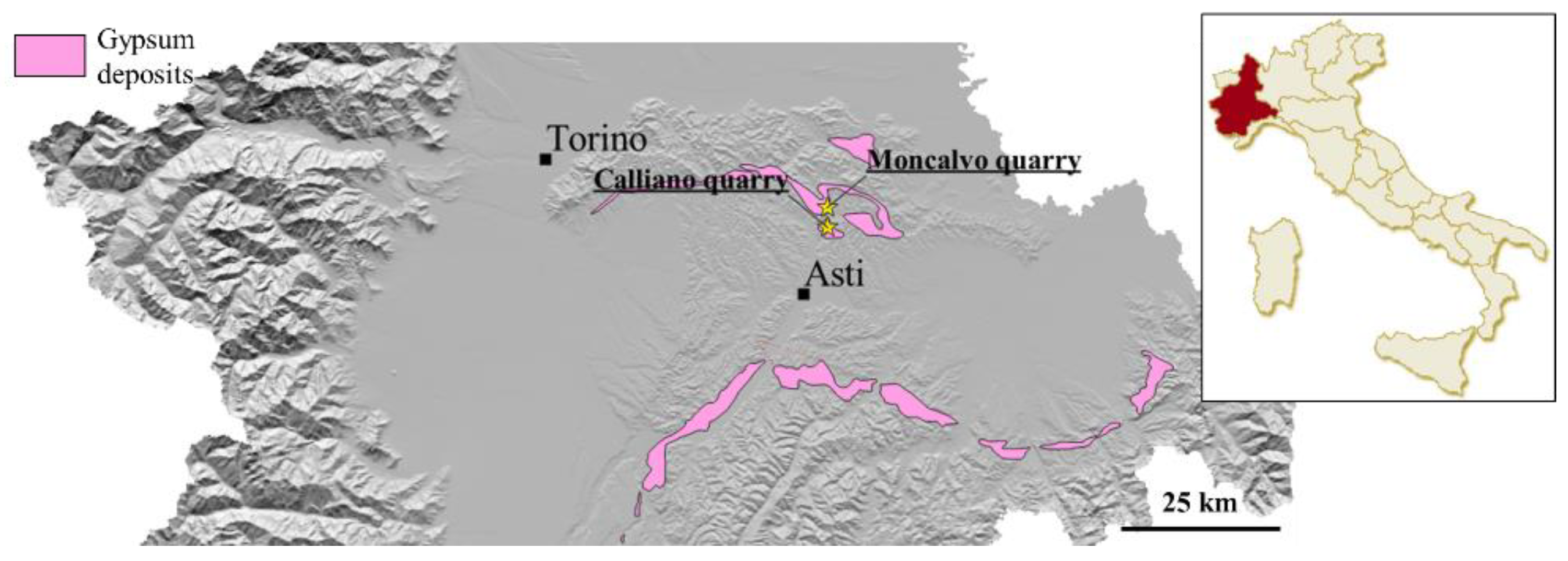
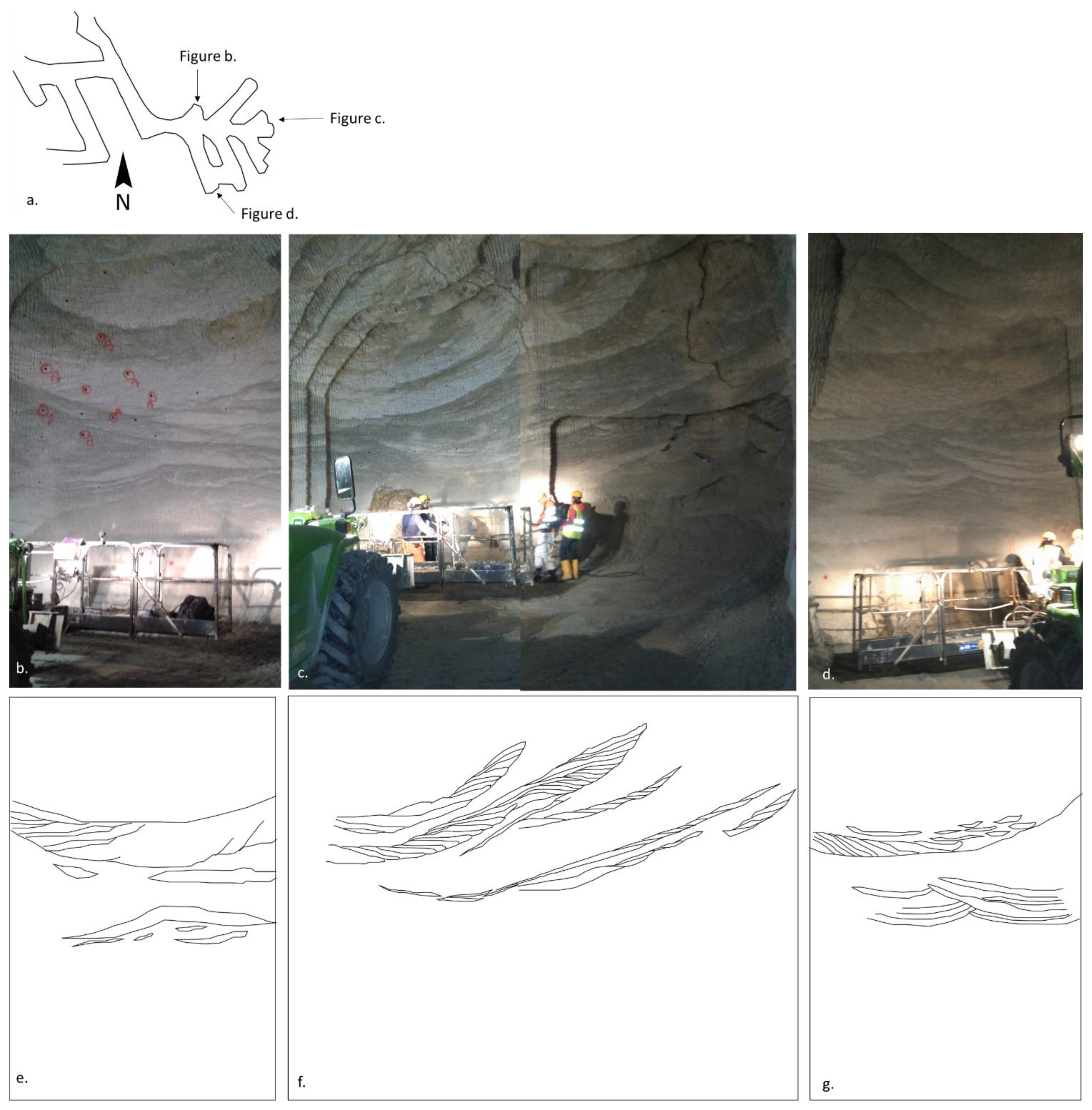
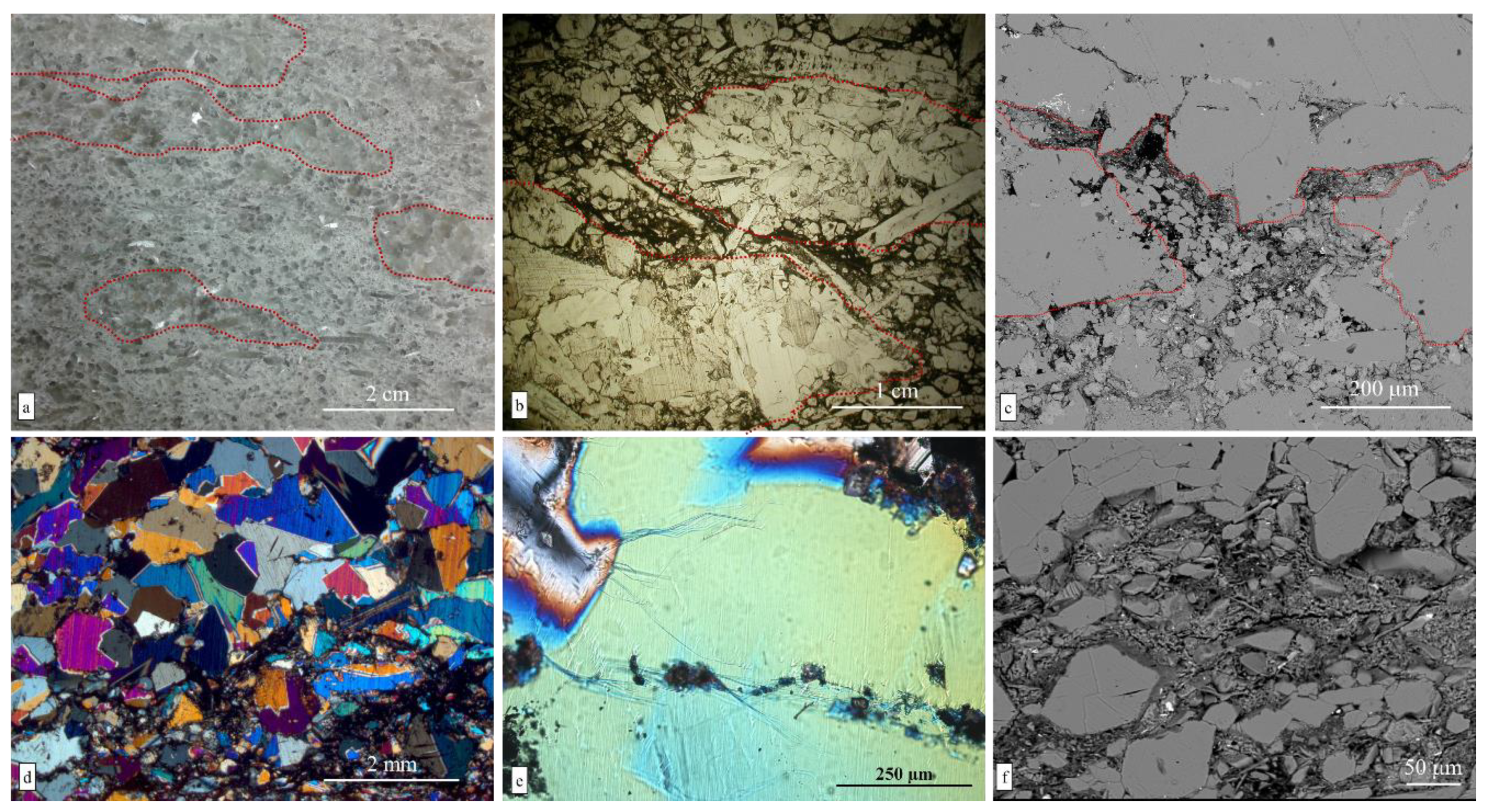
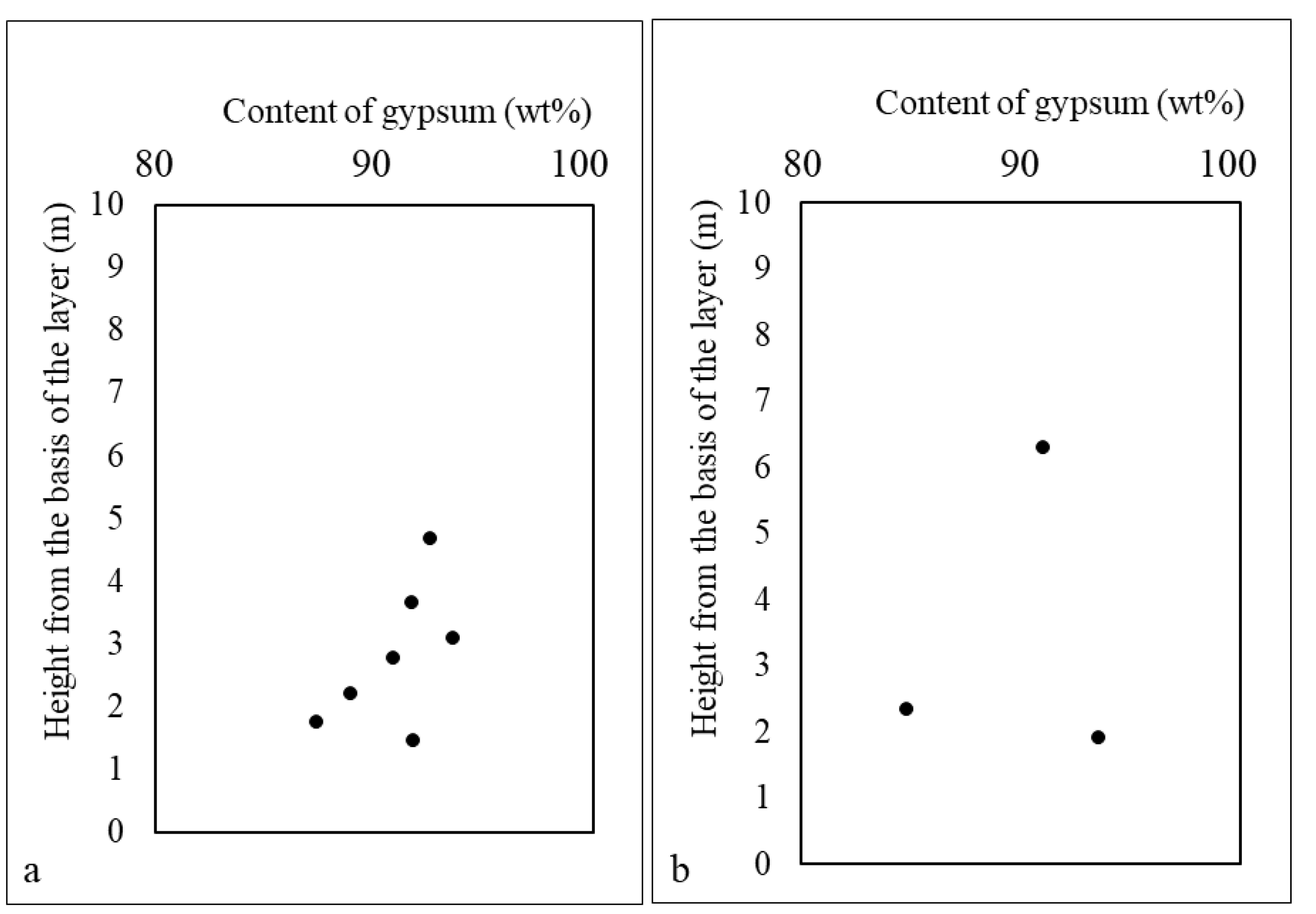

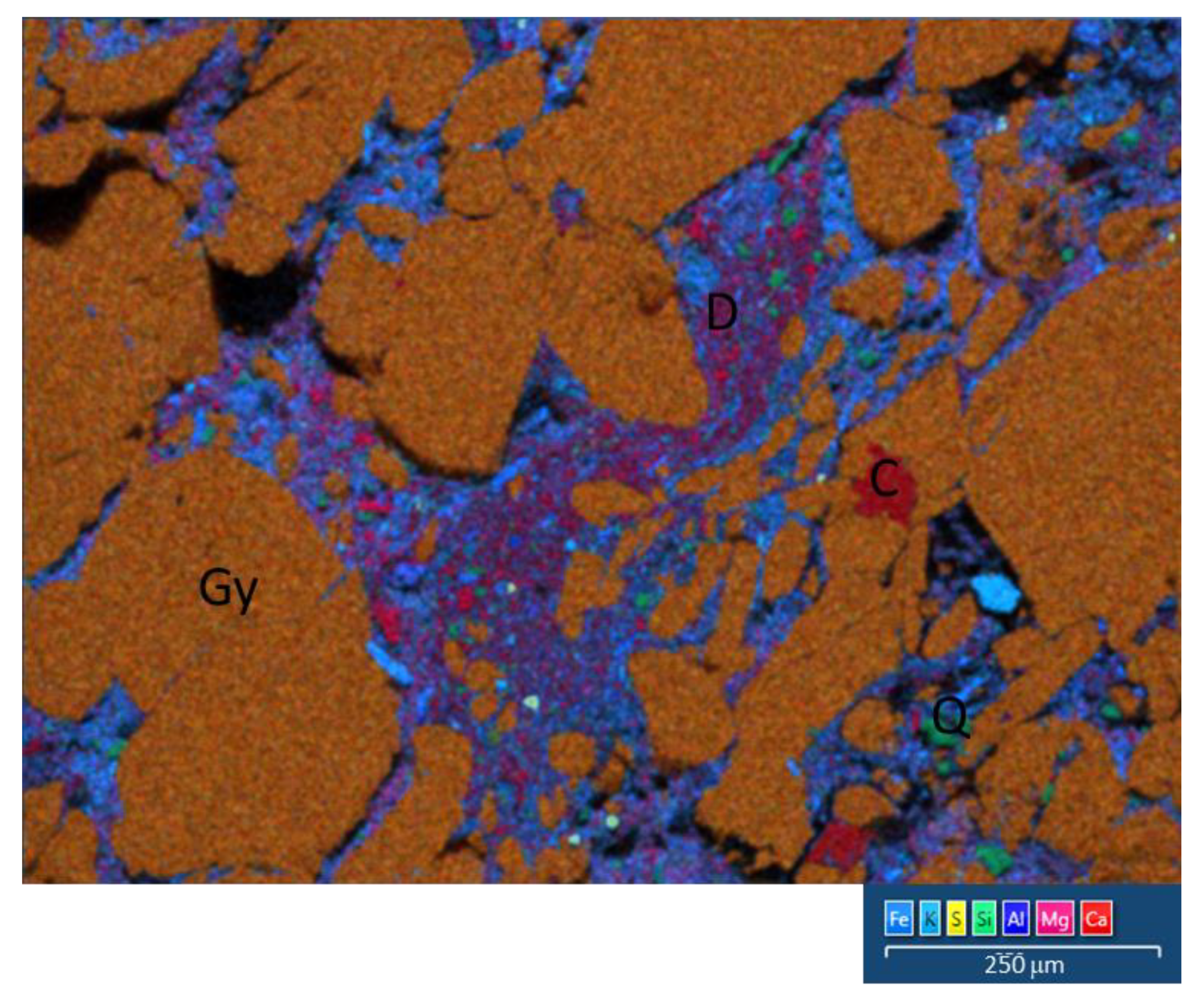
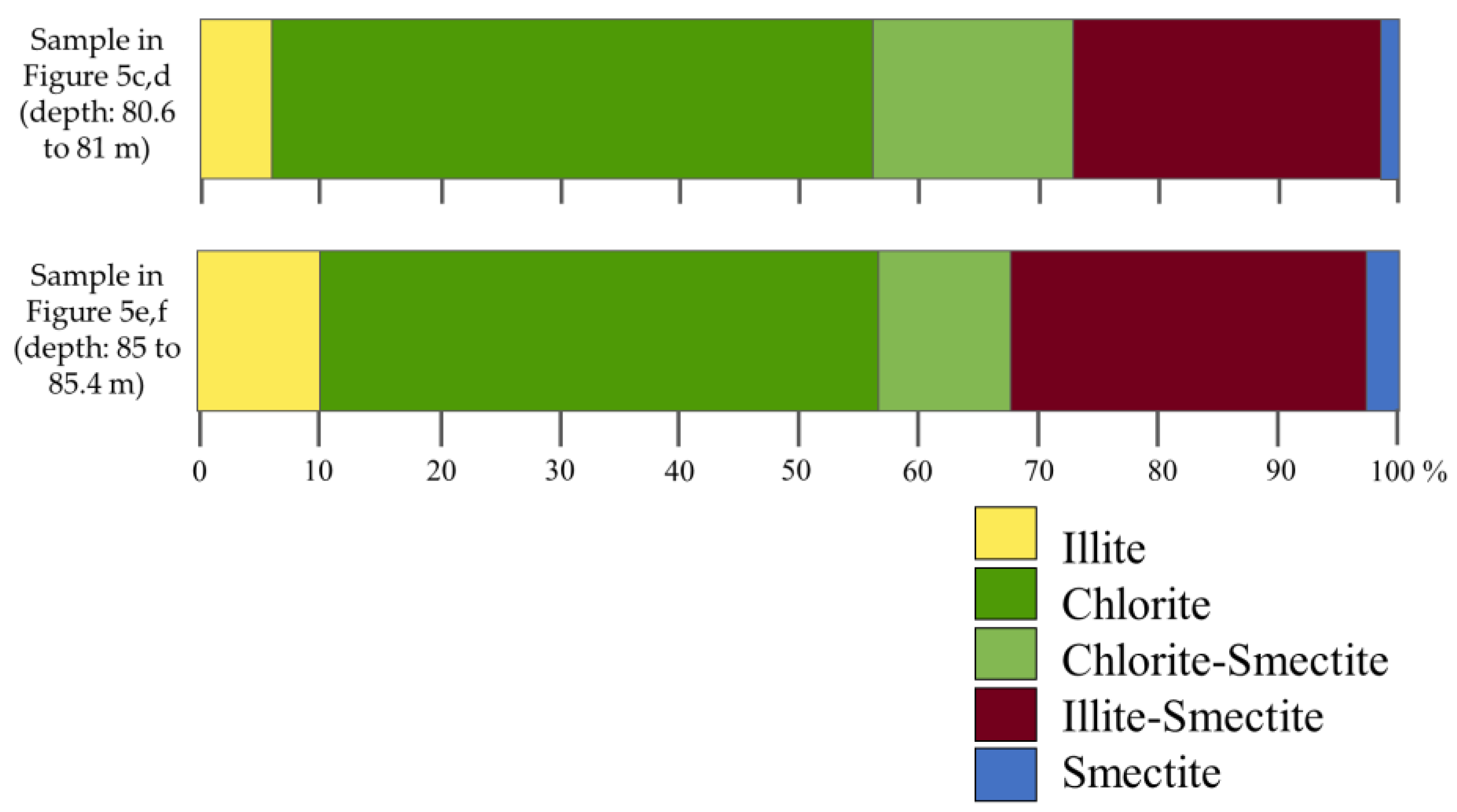
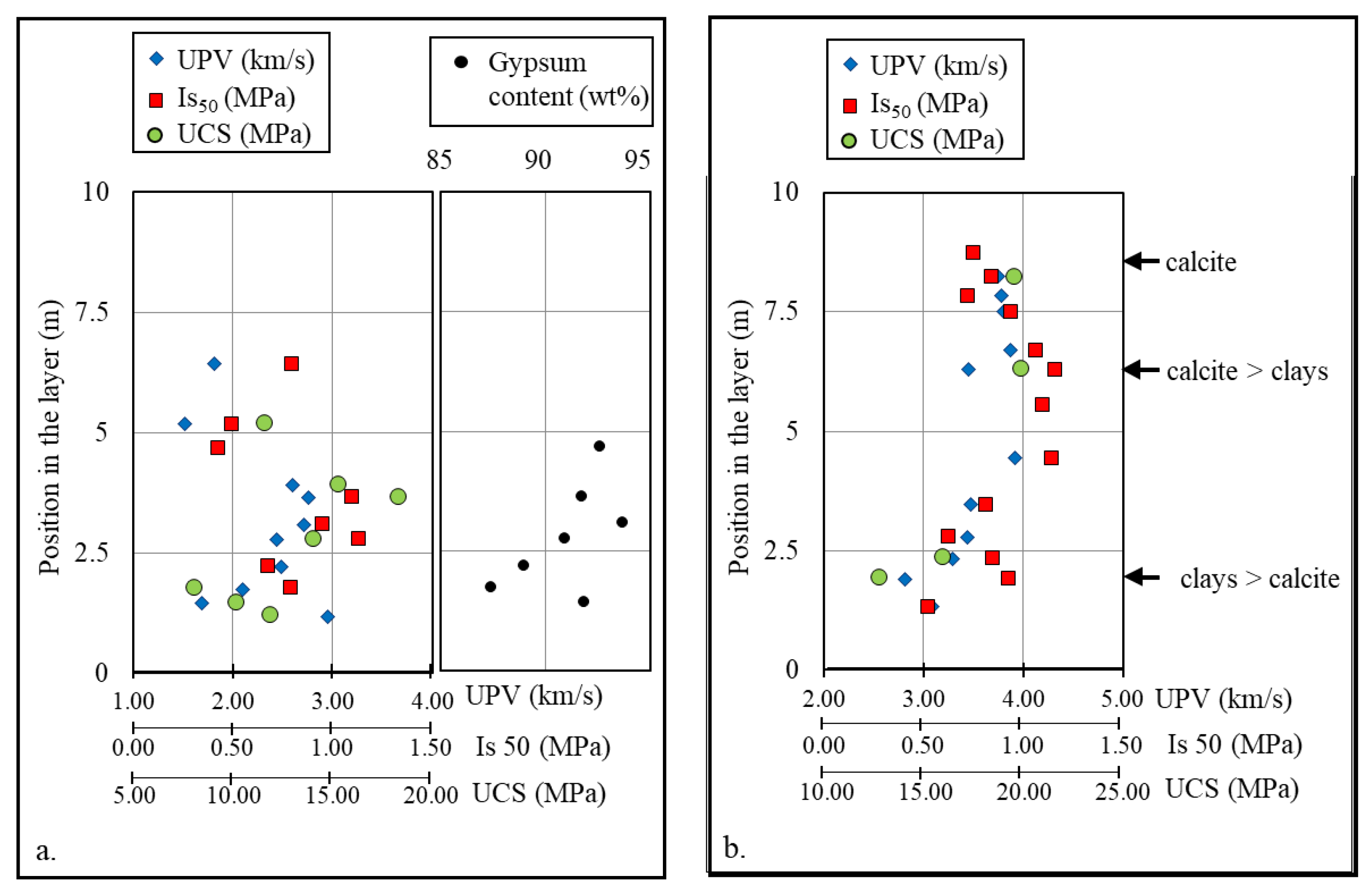
Publisher’s Note: MDPI stays neutral with regard to jurisdictional claims in published maps and institutional affiliations. |
© 2022 by the authors. Licensee MDPI, Basel, Switzerland. This article is an open access article distributed under the terms and conditions of the Creative Commons Attribution (CC BY) license (https://creativecommons.org/licenses/by/4.0/).
Share and Cite
Caselle, C.; Pastero, L.; Cavagna, S.; Bonetto, S. Preliminary Mineralogical Characterization of Branching Selenite Gypsum: New Insights for the Paleoenvironmental Reconstruction and Mechanical Characterization. Minerals 2022, 12, 378. https://doi.org/10.3390/min12030378
Caselle C, Pastero L, Cavagna S, Bonetto S. Preliminary Mineralogical Characterization of Branching Selenite Gypsum: New Insights for the Paleoenvironmental Reconstruction and Mechanical Characterization. Minerals. 2022; 12(3):378. https://doi.org/10.3390/min12030378
Chicago/Turabian StyleCaselle, Chiara, Linda Pastero, Simona Cavagna, and Sabrina Bonetto. 2022. "Preliminary Mineralogical Characterization of Branching Selenite Gypsum: New Insights for the Paleoenvironmental Reconstruction and Mechanical Characterization" Minerals 12, no. 3: 378. https://doi.org/10.3390/min12030378
APA StyleCaselle, C., Pastero, L., Cavagna, S., & Bonetto, S. (2022). Preliminary Mineralogical Characterization of Branching Selenite Gypsum: New Insights for the Paleoenvironmental Reconstruction and Mechanical Characterization. Minerals, 12(3), 378. https://doi.org/10.3390/min12030378







